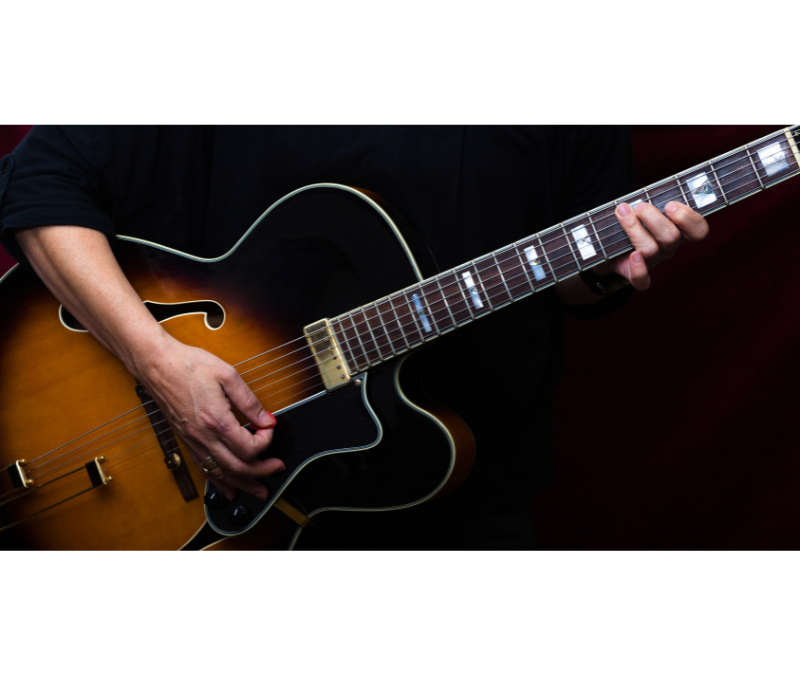Learning to play jazz guitar requires a solid understanding of chord progressions, as they form the harmonic backbone of countless jazz standards. These progressions guide the flow of a song and help create the complex, beautiful sounds that define jazz music. In this blog, we’ll explore some essential jazz chord progressions, and I’ll also introduce JazzCraft, my upcoming book, which provides in-depth guidance on mastering jazz guitar. Plus, I’ll share a few insights into how you can improve your transitions and improvisation over these progressions.
For more support, inspiration, and feedback, don’t forget to join my Discord channel, where you’ll find a community of guitarists working together to master jazz chord progressions.
Why Jazz Chord Progressions Matter
Jazz is built around unique harmonic structures that are often more complex than the simple three-chord progressions found in rock or pop music. Jazz chord progressions, like ii-V-I, I-VI-ii-V, and minor ii-V-i, add richness and movement to the music.
By understanding and practicing these progressions, you’ll be able to:
- Play through jazz standards confidently.
- Improvise over chord changes with ease.
- Improve your ability to create interesting, harmonic solos and comping patterns.

Download the ebook “SoloCraft”!
SoloCraft is the ultimate guide to mastering guitar soloing, designed for players of all levels. Packed with step-by-step lessons, pro-level techniques, and real-world examples, SoloCraft teaches you how to navigate the fretboard, craft expressive solos, and unlock your full potential as a lead guitarist. Whether you’re improvising, building speed, or adding emotion to your playing, SoloCraft gives you the tools to solo like a pro.
Download Now
1. The Classic ii-V-I Progression
The ii-V-I progression is the most essential chord sequence in jazz and is found in virtually every standard. In the key of C, the ii-V-I progression would consist of Dm7 – G7 – Cmaj7. This progression allows for a smooth resolution from the tension of the V7 chord to the stability of the Imaj7 chord.
Practice Prompt:
- Play the ii-V-I progression in all 12 keys. Focus on smooth transitions between each chord and experiment with different inversions of the chords.
As you practice, think about adding extended chords like 9ths and 13ths to bring more color to the progression. These extensions, which are covered in JazzCraft, add depth and sophistication to your playing.
2. The Minor ii-V-i Progression
The minor ii-V-i is the darker, moodier cousin of the ii-V-I progression. This progression is crucial in ballads and minor key standards. In the key of C minor, the progression would be Dm7b5 – G7b9 – Cm7.
Practice Prompt:
- Practice switching between major and minor ii-V progressions. Start with a major ii-V-I (e.g., Dm7 – G7 – Cmaj7) and move directly into a minor ii-V-i (e.g., Dm7b5 – G7b9 – Cm7).
This progression often appears in tunes like “Autumn Leaves” and “My Funny Valentine”, both great examples of how minor ii-V-i transitions create a reflective, melancholic sound.
3. The I-VI-ii-V Progression
The I-VI-ii-V progression is a fundamental turnaround sequence in jazz and is used extensively in standards like “I Got Rhythm” by George Gershwin. This progression cycles through harmonic tension and release, making it a great vehicle for both comping and improvisation.
In C major, this progression would be Cmaj7 – A7 – Dm7 – G7.
Practice Prompt:
- Try playing this progression with altered dominants on the V chords. For example, replace G7 with G7b9 or G7#5 for a more sophisticated sound.
As covered in JazzCraft, learning how to alter dominant chords can add flair and complexity to your comping and soloing, giving you more creative freedom.
4. Rhythm Changes: The I-VI-ii-V in Motion
If you’re familiar with the jazz standard “I Got Rhythm”, you’ve already encountered Rhythm Changes, which is based on the I-VI-ii-V progression. This progression is commonly used in jazz as a fast-moving harmonic structure.
Rhythm Changes can be challenging due to the fast tempo, but it’s one of the most important progressions to master if you want to play in jam sessions.
Practice Prompt:
- Play through Rhythm Changes in different keys and tempos. Focus on keeping the rhythm steady while maintaining smooth transitions between chords.
5. Jazz Blues Progression
The Jazz Blues progression adds a jazzy twist to the traditional 12-bar blues, incorporating more complex chords like dominant 7ths, diminished chords, and ii-V-I turnarounds. One example in C would be:
C7 – F7 – C7 – Gm7 – C7 – F7 – F#dim7 – C7 – A7 – Dm7 – G7 – C7 – G7
This progression creates a rich, soulful sound and is often used in bluesy jazz standards like “Tenor Madness” by Sonny Rollins.
Practice Prompt:
- Work on comping over this progression with syncopated rhythms to give your playing a more relaxed swing feel.
6. The Importance of Chord Voicings and Transitions
Understanding basic jazz chord progressions is one thing, but mastering chord voicings and smooth transitions between chords is what will set you apart as a jazz guitarist. For example, when moving between chords in the ii-V-I progression, it’s important to focus on voice leading, which involves making the smallest movements between chord tones to create smooth harmonic transitions.
Practice Prompt:
- Practice the ii-V-I progression using drop 2 and drop 3 voicings to improve your voice leading. Work on making the transitions between chords as seamless as possible.
Join the Jazz Guitar Community on Discord
Learning jazz guitar, especially when it comes to mastering chord progressions, can be challenging, but you don’t have to go through it alone. By joining my Discord channel, you’ll have access to:
- Exclusive practice tips and exercises from JazzCraft.
- Real-time feedback on your comping and improvisation.
- Live jam sessions where you can practice chord progressions with others.
This community is a great place to ask questions, share your progress, and connect with fellow guitarists who are also working on their jazz chops.
Conclusion: Build Your Jazz Vocabulary
Mastering jazz chord progressions like the ii-V-I, minor ii-V-i, and jazz blues progressions will open up a world of creative possibilities for your playing. These progressions form the backbone of jazz standards, and by practicing them in different keys and with varied voicings, you’ll build a strong foundation for both comping and soloing.
For more in-depth guidance and exercises, don’t forget to check out my upcoming book, JazzCraft, which dives deep into these progressions and more. And of course, join my Discord community to continue learning and improving alongside other passionate jazz guitarists.

Download the ebook “SoloCraft”!
SoloCraft is the ultimate guide to mastering guitar soloing, designed for players of all levels. Packed with step-by-step lessons, pro-level techniques, and real-world examples, SoloCraft teaches you how to navigate the fretboard, craft expressive solos, and unlock your full potential as a lead guitarist. Whether you’re improvising, building speed, or adding emotion to your playing, SoloCraft gives you the tools to solo like a pro.
Download Now










